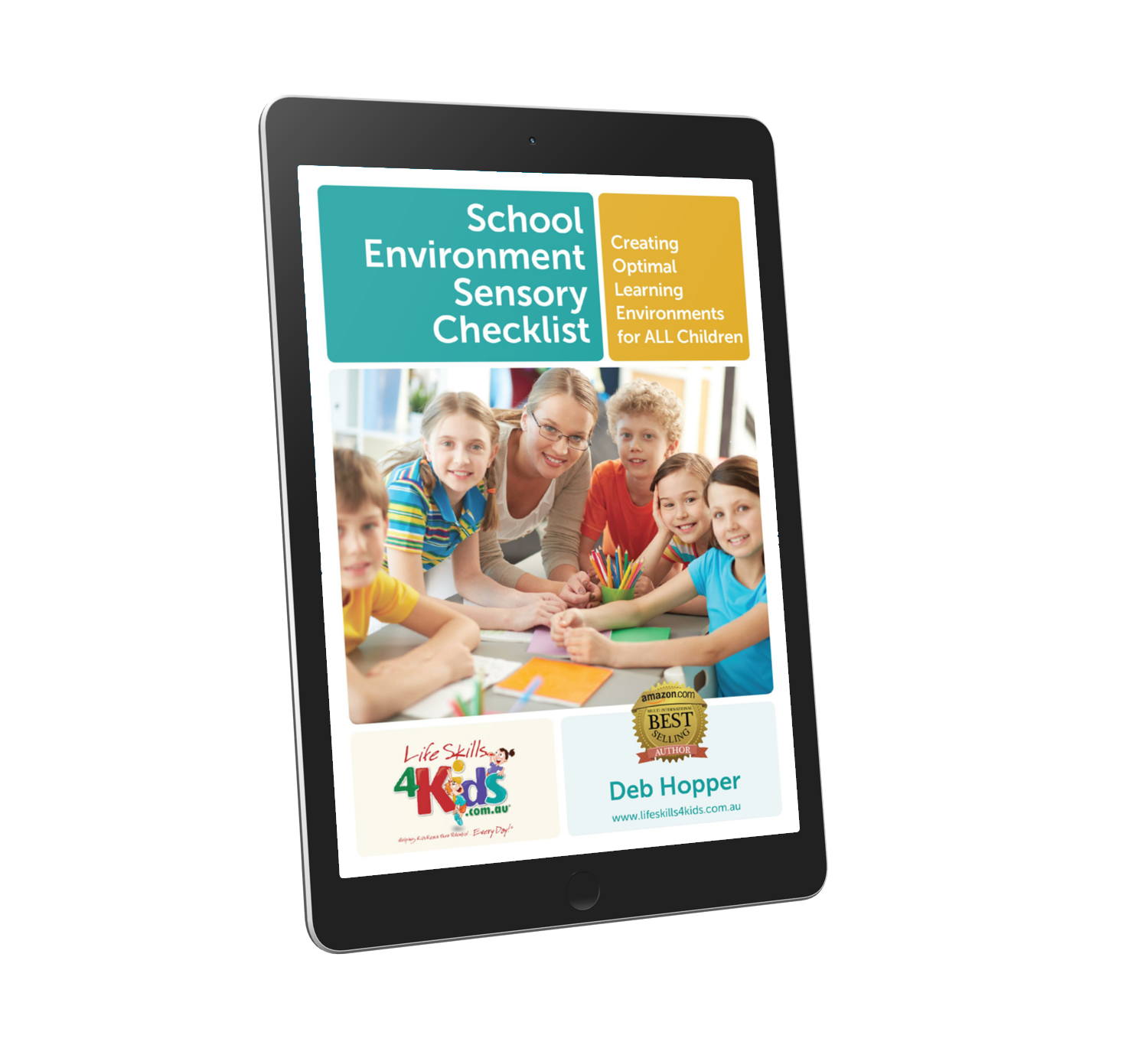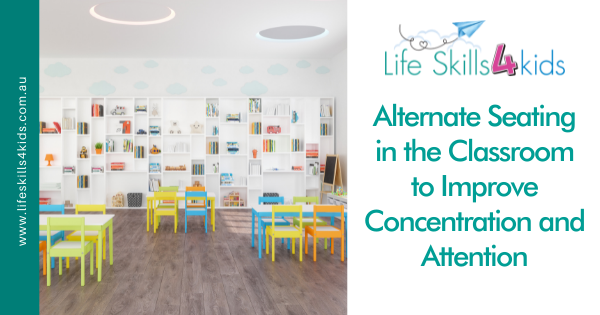Alternate seating in the classroom to improve concentration and attention
The impact of the environment on kids being able to concentrate and attend to learning are becoming much more accepted. Gone are the days when kids had to sit in rows, be silent and never speak until spoken to. (Thank goodness for that!)
It is up to the people who work in the education system to find ways to enable kids to be focussed and attentive. It is becoming accepted that a multi-sensory approach to educate our kids is one which has the greatest chance of success for our unique young people.
A lot of research has been undertaken to find alternate seating which works well in the classroom to enable kids to thrive, be happy and learn. Check out our School Environment Checklist too.
Why Is Alternate Seating In The Classroom Important?
#1. Kids (& Adults too) need to be allowed to move around to learn at their best
- We all work best when we are allowed to get up and have regular breaks.
- With alternate seating available in the classroom environment, kids then have permission to be able to move if they need to.
- There are some great apps available to schedule in regular ‘movement’ time in between work periods.
#2. An element of choice and problem solving is provided by alternate seating options
- With some different seating options in a classroom, kids are enabled to work out how they are feeling and then work out which seating area will help them to focus the best.
- Many of us struggle to allow our feelings to show, providing kids with a framework to do so, is vitally important.
- Check out the Just Right Kids Technique and think about allowing your kids to work out which seating is appropriate for them at particular times.
#3. Alternate seating can promote balance, coordination, core strength and posture
- Not only can different types of seating be important for concentration and focus, they can also help kids with building a physically strong body.
- We all know that if we can start to make our bodies strong at the beginning of our lives, this will help us in all aspects and times of our life.
- There is a plethora of evidence to back up the importance of having a strong body core which in turn can promote a healthy mind and increased concentration and attention.
- The element of ‘fun’ of having different seating options is great because kids will love to move around when sitting on an exercise ball, without realising how much “good” they are doing for themselves!
#4. Physical Activity promotes improved health, behaviour and academic achievement
- Kids are not designed to sit still. Actually, we need to fill our nervous system with movement BEFORE we are able to sit and concentrate. We need to teach children that moving before concentration and learning is a hack for life!
- A lot of kids need to fidget to help themselves concentrate and we need to embrace and understand this and allow accommodations for fidgeting in the classroom environment.
- With increased seating options, we can stop worrying about kids moving around and focus instead of helping them to learn in a way that works for them.
#5. Promoting Trust Allows For Kids To Thrive
- It can be a scary thought, as a teacher, of giving kids choices of what sort of furniture they want to sit on and whereabouts in the classroom they prefer to be.
- But, as we are willing to take the leap and allow for that freedom, we can be rewarded with kids who feel trusted to become free-thinking, unique individuals.
A Guide To Alternate Seating in The Classroom
At Life Skills 4 Kids, we have written several articles on planning your classroom environment. While you are thinking about alternate seating in the classroom, you may want to have a classroom detox, or re-visit your classroom productivity.
However you choose to organise your environment, here is a selection of the types of alternate seating in the classroom that you may want to include.
#1. Therapy/Exercise Balls
- An exercise ball is a well-used seating option which kids & adults can benefit from
- Your mind and body will be focused while sitting on the ball
- This enables the rest of your mind and body to focus on the task in hand
- The movement flow of the ball can facilitate a positive work flow without the child even realising it.
#2. Bean bag chairs/floor cushions
- Many activities that we do as adults eg reading, writing, computers etc, are things that we like to do when we have got ourselves comfortable.
- Providing kids with comfortable, relaxed seating options will enable them to learn in their optimum environment.
- Bean bags also encourage a flexed seating posture and lots of lovely deep touch pressure as we wiggle into it. This is both calming and organising and for a child who is overwhelmed can be a life saver.
#3. “Work” Floor space
- Some kids prefer to work on the floor, so providing a space for this is important.
- You can provide clipboards or a lap desk to enable these kids to choose their preferred learning zone.
- Encouraging children to lie on their tummies to read or write is fabulous for increasing shoulder and upper limb strength and back extension – to counter all the time hunched over looking at screens.
#4. Standing Desks
- Many kids works best when they are standing up.
- Adults like to do this too, when we are brainstorming or thinking, the act of walking up and down and physically moving around can be very empowering for our ideas.
- You may have some visual learners who will thrive on being able to ‘see’ the bigger picture of their work by choosing to stand.
#5. Lap Desks
- Lap desks can not only be added to the “work” floor space but also to areas with bean bags or different types of chairs.
- They are also very individual and provide a child with their own personal space.
#6. Wobble Stools/Rocker Chairs
- If kids need to constantly move, but perhaps do not get on with exercise balls, there are many different sorts of stools and chairs which are designed to allow the kids to move whilst sitting.
- If you are unsure what to look for, get help from an Occupational Therapist who is involved with your school.
#7. T-stools
- T-stools promote balance and enable kids to find their own centre of gravity.
- The act of doing this can be a great way of allowing the child to focus their bodies first and then their minds on the task in hand.
- Use T-stools for short periods as they can be very tiring for children with low muscle tone and poor core stability.
Using alternate seating in the classroom can be implemented in small steps. Not all alternate seating is perfect for all children. Some children do become too busy or fast with some seating. Try lots of options and don’t give up. Be a sensory detective and work out what seating options are good for each child.
School Environment Sensory Checklist (eBook)
Do you have children in your class who struggle with autism, learning difficulties or reduced concentration? Then the School Environment Sensory Checklist (SESC) is your entry into transforming your classroom!
Quickly and easily evaluate your classroom from a sensory perspective to enhance learning needs of all children, including children with autism and learning difficulties.
Have less distracted children who listen for longer and enjoy times of focused learning and easier transitions. Whether you are a newly qualified teacher or have many years experience, the School Environment Sensory Checklist (SESC) will refresh your vision for your classroom!


